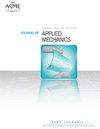An Entropy Dynamics Approach for Deriving and Applying Fractal and Fractional Order Viscoelasticity to Elastomers
IF 2.8
4区 工程技术
Q2 MECHANICS
引用次数: 0
Abstract
Entropy dynamics is a Bayesian inference methodology that can be used to quantify time-dependent posterior probability densities that guide development of complex material models using information theory. Here we expand its application to non-Gaussian processes to evaluate how fractal structure can influence fractional hyperelasticity and viscoelasticity in elastomers. We investigate how kinematic constraints on fractal polymer network deformation influences the form of hyperelastic constitutive behavior and viscoelasticity in soft materials such as dielectric elastomers which have applications in the development of adaptive structures. The modeling framework is validated on two dielectric elastomers, VHB 4910 and 4949, over a broad range of stretch rates. It is shown that local fractal time derivatives are equally effective at predicting viscoelasticity in these materials in comparison to non-local fractional time derivatives under constant stretch rates. We describe the origin of this accuracy which has implications for simulating larger scale problems such as finite element analysis given the differences in computational efficiency of non-local fractional derivatives versus local fractal derivatives.弹性体分形和分数阶粘弹性的熵动力学推导和应用
熵动力学是一种贝叶斯推理方法,可用于量化与时间相关的后验概率密度,指导使用信息论开发复杂材料模型。在这里,我们将其应用于非高斯过程,以评估分形结构如何影响弹性体中的分数超弹性和粘弹性。我们研究了分形聚合物网络变形的运动学约束如何影响软材料(如电介质弹性体)中超弹性本构行为和粘弹性的形式,这些材料在自适应结构的开发中有应用。建模框架在两种介电弹性体VHB 4910和4949上进行了验证,拉伸速率范围很广。结果表明,在恒定拉伸速率下,与非局部分数时间导数相比,局部分形时间导数在预测这些材料的粘弹性方面同样有效。鉴于非局部分数导数与局部分形导数的计算效率不同,我们描述了这种精度的起源,这对模拟更大规模的问题(如有限元分析)具有启示意义。
本文章由计算机程序翻译,如有差异,请以英文原文为准。
求助全文
约1分钟内获得全文
求助全文
来源期刊
CiteScore
4.80
自引率
3.80%
发文量
95
审稿时长
5.8 months
期刊介绍:
All areas of theoretical and applied mechanics including, but not limited to: Aerodynamics; Aeroelasticity; Biomechanics; Boundary layers; Composite materials; Computational mechanics; Constitutive modeling of materials; Dynamics; Elasticity; Experimental mechanics; Flow and fracture; Heat transport in fluid flows; Hydraulics; Impact; Internal flow; Mechanical properties of materials; Mechanics of shocks; Micromechanics; Nanomechanics; Plasticity; Stress analysis; Structures; Thermodynamics of materials and in flowing fluids; Thermo-mechanics; Turbulence; Vibration; Wave propagation

 求助内容:
求助内容: 应助结果提醒方式:
应助结果提醒方式:


